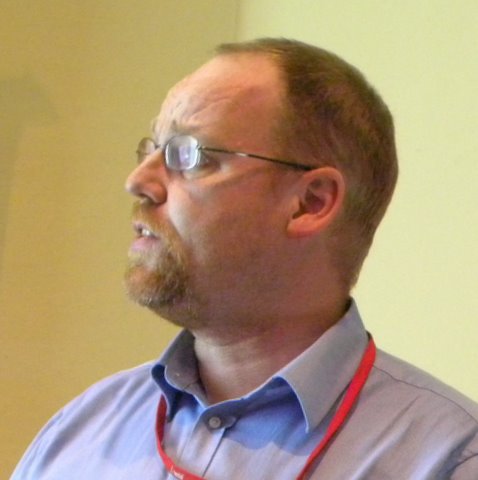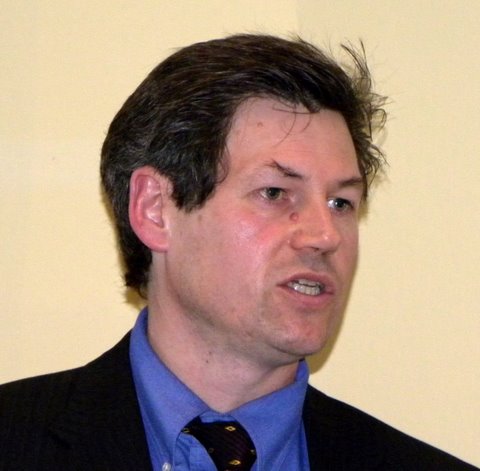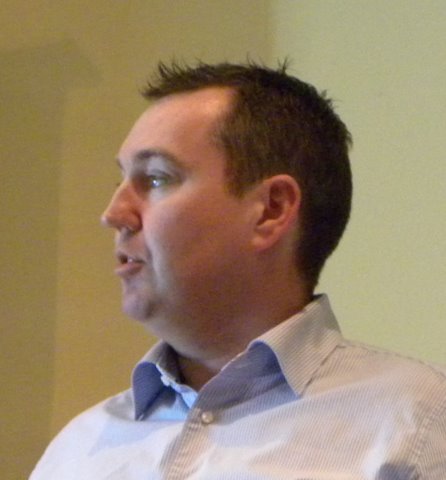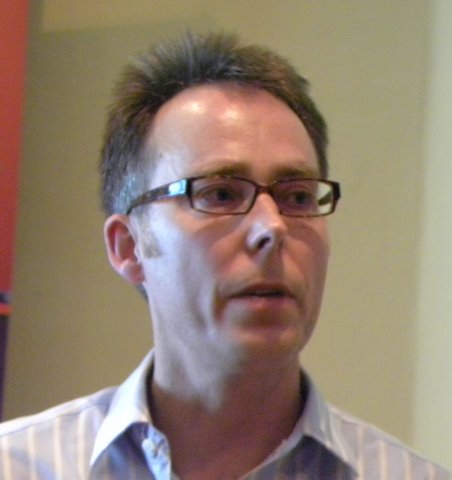The Institute of Circuit Technology Darlington Evening Seminar
2nd November 2010
Cold, dark, wet, windy; great drifts of soggy fallen leaves: driving into Darlington in the north-east of England on the evening of 2nd November was not the most inspirational of experiences! But British PCB guys are robust and resilient, and a fair crowd congregated at the Devonport Hotel for another excellent technical seminar and networking event organised with support from Merlin Flex-Ability Ltd and introduced by Institute of Circuit Technology Technical Director Bill Wilkie.
 Martin Wickham from National Physical Laboratory gave the first presentation, a comparison of via reliability after lead-free soldering using thermal cycling and interconnection stress testing. Objectives of the project were to evaluate the effects of via proximity and the inclusion or exclusion of non-functional pads, and to compare the relative performance of the two test methods. Test coupons were based on a 10-layer daisy-chain design of 2.5 mm finished thickness, with 10:1 aspect-ratio via holes on 1.0 and 0.8 mm pitch. Microvias were included in the design. The coupons were subjected to reflow conditioning in a 7-zone oven with a peak temperature of 260°C before testing. Thermal cycling conditions were 3000 cycles -55°C to +150°C with 5 minute dwell and all substrates were continuously monitored. Failure was indicated if chain resistance exceeded 5K?. Interconnection stress test coupons were heated from ambient to 150°C in 3 minutes and cooled back to ambient in 2 minutes, with continuous resistance monitoring. The 10% rejection criterion was 100 milliohms. The test results indicated that there were no significant differences in via reliability between fine and coarse grid pitches. Coupons with immersion silver finish and high aspect ratio vias showed earlier failure if non-functional pads were left in place. The two test methods gave comparable results: interconnection stress testing was good if a rapid evaluation was required, thermal cycling was preferred if a wide range of experimental parameters were to be tested. Wickham remarked that test coupon manufacturing consistency was an issue: some data had to be discarded as a consequence of variable copper plating thickness and brittle electroless nickel.
Martin Wickham from National Physical Laboratory gave the first presentation, a comparison of via reliability after lead-free soldering using thermal cycling and interconnection stress testing. Objectives of the project were to evaluate the effects of via proximity and the inclusion or exclusion of non-functional pads, and to compare the relative performance of the two test methods. Test coupons were based on a 10-layer daisy-chain design of 2.5 mm finished thickness, with 10:1 aspect-ratio via holes on 1.0 and 0.8 mm pitch. Microvias were included in the design. The coupons were subjected to reflow conditioning in a 7-zone oven with a peak temperature of 260°C before testing. Thermal cycling conditions were 3000 cycles -55°C to +150°C with 5 minute dwell and all substrates were continuously monitored. Failure was indicated if chain resistance exceeded 5K?. Interconnection stress test coupons were heated from ambient to 150°C in 3 minutes and cooled back to ambient in 2 minutes, with continuous resistance monitoring. The 10% rejection criterion was 100 milliohms. The test results indicated that there were no significant differences in via reliability between fine and coarse grid pitches. Coupons with immersion silver finish and high aspect ratio vias showed earlier failure if non-functional pads were left in place. The two test methods gave comparable results: interconnection stress testing was good if a rapid evaluation was required, thermal cycling was preferred if a wide range of experimental parameters were to be tested. Wickham remarked that test coupon manufacturing consistency was an issue: some data had to be discarded as a consequence of variable copper plating thickness and brittle electroless nickel.
 Polar Instruments Applications Support Engineer James Stapley discussed methods of calculating, specifying and measuring electrical characteristics of PCBs, in an enlightening presentation about practical aspects of controlled impedance, loss simulation and test. Designers and fabricators now had access to material libraries and the facility to simulate trace geometries, make accurate prediction of impedance and communicate clearly documented stack-up information to each other, and good communication saved costly rebuilds. Accurate modelling was critically important, although in real multilayer constructions, the detail local distribution of glass and resin could lead to variances between calculated and actual dielectric values, requiring meaningful tolerances to be applied. Material selection was critical to the performance of the final product. Solder mask could have a dramatic effect on the impedance of surface traces, as much as 10? depending on geometry, and needed to be taken into account in the modelling. Stapley commented that all models were wrong, but some were useful! Historically, impedance modelling assumed lines to be loss-less, but future trends to finer line-widths and higher operating frequencies would result in increased dielectric loss and skin loss in transmission lines, and these would need to be taken into consideration in modelling and testing. Regarding impedance testing, time domain reflectometry had evolved to be straightforward and robust, and it was important to recognise that TDR testing was a manufacturing validation, rather than a design validation.
Polar Instruments Applications Support Engineer James Stapley discussed methods of calculating, specifying and measuring electrical characteristics of PCBs, in an enlightening presentation about practical aspects of controlled impedance, loss simulation and test. Designers and fabricators now had access to material libraries and the facility to simulate trace geometries, make accurate prediction of impedance and communicate clearly documented stack-up information to each other, and good communication saved costly rebuilds. Accurate modelling was critically important, although in real multilayer constructions, the detail local distribution of glass and resin could lead to variances between calculated and actual dielectric values, requiring meaningful tolerances to be applied. Material selection was critical to the performance of the final product. Solder mask could have a dramatic effect on the impedance of surface traces, as much as 10? depending on geometry, and needed to be taken into account in the modelling. Stapley commented that all models were wrong, but some were useful! Historically, impedance modelling assumed lines to be loss-less, but future trends to finer line-widths and higher operating frequencies would result in increased dielectric loss and skin loss in transmission lines, and these would need to be taken into consideration in modelling and testing. Regarding impedance testing, time domain reflectometry had evolved to be straightforward and robust, and it was important to recognise that TDR testing was a manufacturing validation, rather than a design validation.
 Martin Wickham returned to report the progress of the NPL Joint Industry Project on delamination and storage issues with printed circuit boards, observing and measuring the mechanism and effects of moisture absorption. He described the details of two measurement methods that had been evaluated: route impulse energy and capacitance. The route impulse energy technique used time domain reflectometry, and measured the difference in loss between two identically constructed PCB transmission lines of different lengths, with similar test equipment to that used for routine impedance measurement andsome additional software. Good correlation between RIE and moisture ingression had been observed, and a significant change in RIE was measured on 6-layer test boards after 2-3 days damp heat conditioning. The method could potentially be used for delamination measurement if delamination occurred between signal line and ground plane. The capacitance method gave a meaningful measure of moisture content as a means of detecting conditions for early failure through delamination. A mass increase of 0.35% due to water absorption corresponded to a capacitance increase of around 10%, and capacitance measurement showed no obvious distinction between board types. Wickham went on to explain how moisture uptake effects could be modelled, and showed some surprising results on moisture distribution within PCBs during baking. In certain cases, baking resulted in driving moisture further into the structure of the board. Boards that were stored in high temperature and humidity environments absorbed greater amounts of moisture than those stored in cooler environments, making them more prone to delamination during the reflow process. The general conclusion was “Store in a cool dry place”
Martin Wickham returned to report the progress of the NPL Joint Industry Project on delamination and storage issues with printed circuit boards, observing and measuring the mechanism and effects of moisture absorption. He described the details of two measurement methods that had been evaluated: route impulse energy and capacitance. The route impulse energy technique used time domain reflectometry, and measured the difference in loss between two identically constructed PCB transmission lines of different lengths, with similar test equipment to that used for routine impedance measurement andsome additional software. Good correlation between RIE and moisture ingression had been observed, and a significant change in RIE was measured on 6-layer test boards after 2-3 days damp heat conditioning. The method could potentially be used for delamination measurement if delamination occurred between signal line and ground plane. The capacitance method gave a meaningful measure of moisture content as a means of detecting conditions for early failure through delamination. A mass increase of 0.35% due to water absorption corresponded to a capacitance increase of around 10%, and capacitance measurement showed no obvious distinction between board types. Wickham went on to explain how moisture uptake effects could be modelled, and showed some surprising results on moisture distribution within PCBs during baking. In certain cases, baking resulted in driving moisture further into the structure of the board. Boards that were stored in high temperature and humidity environments absorbed greater amounts of moisture than those stored in cooler environments, making them more prone to delamination during the reflow process. The general conclusion was “Store in a cool dry place”

Mark Merifield, Operations Manager of Merlin Flex-Ability, gave a very informative presentation on designing flexible circuits to meet present-day reliability, cost and lead-time demands. He stressed the importance of the designer establishing a good line of engineering communication with the manufacturer as early as possible in the design cycle, understanding what were preferred panel formats for assembly and test, how to get good material utilisation, and how to correctly specify profile tooling with regard to quantity and dimensional tolerance requirements. Material selection was particularly significant: wherever possible standard materials were preferred, copper thickness 18 or 35 micron and polyimide thickness 25 or 50 micron. Costs and lead-times increased dramatically if non-standard materials or builds were specified. Merifield reviewed general application requirements: physical, electrical and mechanical, and typical layout and design rules. He listed Merlin Flex-Ability’s standard manufacturing capabilities and design preferences. His general advice was to get the manufacturer involved early, to design in accordance with IPC2223, to keep the design within standard manufacturing capabilities and to use standard constructions and materials wherever possible.

The final presentation came from ICT Vice-Chairman Dr Andy Cobley, with a brief update on proof-of-concept experiments carried out at Coventry University’s Sonochemistry Centre on the effect of ultrasound in the permanganate desmear process. A proprietary permanganate desmear process had been operated at various concentrations and temperatures, with and without ultrasonic agitation. Weight loss had been measured on FR4 laminate, and plated-through holes had been visually assessed by scanning electron microscopy. It had been observed that ultrasound always produced higher weight loss on coupons than the equivalent process without ultrasound, that smear removal was generally better with ultrasound than without, and that ultrasound enabled the production of samples free of interconnection defects with full strength and half strength permanganate at 60ºC
Each of the presentations sparked lively interactive discussion, and some informal debate carried on well into the evening. A group of laminators congregated in the bar, reminisced about the good old days, as laminators generally tend to on such occasions, and argued at length about the relative merits of their competitors’ products. When someone suggested it was bed-time, a faint voice from the back was heard to protest: “But we haven’t talked about bow and twist yet…”
Pete Starkey
November 2010
